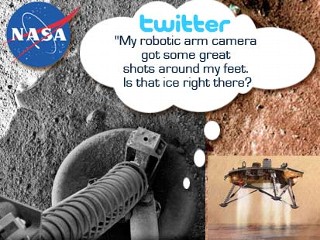Phoenix Sends Messages from Mars to Cell Phones, IM Via Twitter
4:46 p.m., May 25: Atmospheric entry has started. time to get REALLY nervous. Now I'm in the "seven minutes of terror."
4:50 p.m.: Parachute is open!!!!! come on rocketssssss!!!!!
4:54 p.m.: I've landed!!!!!!!!!!!!!
4:55 p.m. Cheers! Tears!! I'm here!
When the Phoenix Lander, NASA's spacecraft that is looking for signs of life -- or at least ice -- on Mars, landed two weeks ago it, had an audience of thousands, but it was all online, not on cable or the nightly TV newscast.
Web-savvy space fans have tuned into the spacecraft's Twitter page, where Phoenix has been "tweeting" back daily messages from space. The page has quickly become one of Twitter's most popular feeds, and turned Phoenix into a rising star.
Of course, this Phoenix is not a cutesy, talking robot turned spacecraft. Instead, the Lander's adventures appear online at Twitter.com, the social networking and micro-blogging site. The part of Phoenix is played by human: Veronica McGregor, the media director of NASA's Jet Propulsion Laboratory.
"The feedback has been tremendous," McGregor told me from California, where JPL is based. "Every day, we get hundreds and hundreds of replies. I put out a question one night. Should I reply to everybody or individuals [when answering questions]. Within minutes, I had 95 responses and every single person said, 'No, send them to all of us.'"
Twitter.com allows users to send out 140-character messages to their Twitter feed via e-mail, instant messaging or text-messaging. Twitter operates somewhat like a personal RSS feed; people who subscribe to your feed will receive all the messages you send out.
That means that the nearly 17,000 subscribers Phoenix's feed has netted since it began nearly a month ago have been receiving wide-eyed, enthusiastic messages like this one.
June 1: Looking forward to an exciting day on Mars; My first dig in the dirt! Team calls this a "dig and dump" test of my robotic arm and scoop.
McGregor, a former space reporter for CNN, writes as Phoenix about a dozen times a day, before and after work. She normally doesn't have time to post to Twitter during her regular workday.
May 28: It's very humbling, and thrilling that so many people care to follow. Want to be careful I don't "over-twitter" my welcome.
In addition to straightforward updates, McGregor spends a lot of time answering questions posed to her by other users about weather, cameras and how long it takes a signal to travel back to Earth. (Answer: 15 minutes at about 186,000 miles per second.) This isn't the first time that NASA has ventured into Web 2.0, but it is the first time it's been so successful. JPL has a Facebook page with just a few hundred users, and NASA has also blogged about other missions in the past without much incident.
"It was during one of our weekly staff meetings, and we were talking about the landing blog we were going to do," McGrego said. "One staffer said, 'Why don't we try Twitter?' Half of us in the room, including me, said, 'What's Twitter?'"
By the time, Phoenix landed, the site had 3,000 subscribers and is still growing. In the past 24 hours, it has netted more than 1,500 new subscribers.
"It's always hard for us to get our missions in the news. The news editors think that the public has a certain appetite for these things, and maybe they do for a full-length story," she said.
But as the project continued, McGregor said she kept receiving messages saying they liked getting short updates.
"I think that's the key thing," she said. "People just love getting that tidbit of news without having to sit down and read an entire story." For McGregor, the challenge is how to keep people interested in the mission, especially during the downtime of a coming Mars fall.
"I said I do it as long as people are following and as long as Phoenix is working," she said. "Eventually we'll have to sign-off and say goodbye."
June 3: Sci team is done with today's news briefing. They'll be back on the clock to start the Martian work shift at 9:30pm PDT. Mars time is rough.




No comments:
Post a Comment